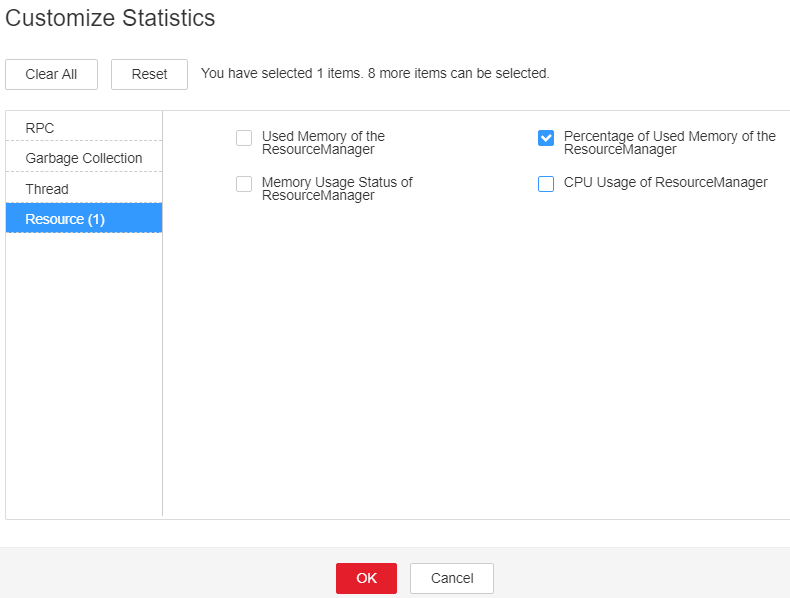ALM-18016 Non Heap Memory Usage of ResourceManager Exceeds the Threshold
Description
The system checks the Non Heap memory usage of Yarn ResourceManager every 30 seconds and compares the actual usage with the threshold. The alarm is generated when the Non Heap memory usage of Yarn ResourceManager exceeds the threshold (90% of the maximum memory by default).
Users can choose O&M > Alarm > Thresholds > Name of the desired cluster > Yarn to change the threshold.
The alarm is cleared when the Non Heap memory usage is less than or equal to the threshold.
Attribute
|
Alarm ID |
Alarm Severity |
Automatically Cleared |
|---|---|---|
|
18016 |
Major |
Yes |
Parameters
|
Name |
Meaning |
|---|---|
|
Source |
Specifies the cluster for which the alarm is generated. |
|
ServiceName |
Specifies the service name for which the alarm is generated. |
|
RoleName |
Specifies the role name for which the alarm is generated. |
|
HostName |
Specifies the object (host ID) for which the alarm is generated. |
|
Trigger Condition |
Specifies the threshold triggering the alarm. If the current indicator value exceeds this threshold, the alarm is generated. |
Impact on the System
When the Non Heap memory usage of Yarn ResourceManager is overhigh, the performance of Yarn task submission and operation is affected. In addition, a memory overflow may occur so that the Yarn service is unavailable.
Possible Causes
The Non Heap memory of the Yarn ResourceManager instance on the node is overused or the Non Heap memory is inappropriately allocated. As a result, the usage exceeds the threshold.
Procedure
Check the Non Heap memory usage.
- On the FusionInsight Manager portal, choose O&M > Alarm > Alarms > ALM-18016 Non Heap Memory Usage of Yarn ResourceManager Exceeds the Threshold > Location. Check the HostName of the instance for which the alarm is generated.
- On the FusionInsight Manager portal, choose Cluster > Name of the desired cluster > Services > Yarn > Instance > ResourceManager. Click the drop-down menu in the upper right corner of Chart, choose Customize > Percentage of Used Memory of the ResourceManager. ResourceManager indicates the corresponding HostName of the instance for which the alarm is generated. Check the Non Heap memory usage.
Figure 1 Percentage of Used Memory of the ResourceManager

- Check whether the used Non Heap memory of ResourceManager reaches 90% of the maximum Non Heap memory specified for ResourceManager by default.
- On the FusionInsight Manager portal, choose Cluster > Name of the desired cluster > Services > Yarn > Configurations > All Configurations > ResourceManager > System. Adjust the GC_OPTS memory parameter of ResourceManager. Save the configuration and restart the ResourceManager instance.

- Restarting the active ResourceManager instance will trigger a active/standby switchover of the ResourceManager instance. During the switchover, Yarn cannot submit new jobs, but submitted jobs are not affected. The Yarn component and components that depend on Yarn generate service unavailable alarms for a short period of time.
Restart the standby ResourceManager instance. Services are not affected.
- The mapping between the number of NodeManager instances in a cluster and the memory size of ResourceManager is as follows:
- If the number of NodeManager instances in the cluster reaches 100, the recommended JVM parameters of the ResourceManager instance are as follows: -Xms4G -Xmx4G -XX:NewSize=512M -XX:MaxNewSize=1G
- If the number of NodeManager instances in the cluster reaches 200, the recommended JVM parameters of the ResourceManager instance are as follows: -Xms6G -Xmx6G -XX:NewSize=512M -XX:MaxNewSize=1G
- If the number of NodeManager instances in the cluster reaches 500, the recommended JVM parameters of the ResourceManager instance are as follows: -Xms10G -Xmx10G -XX:NewSize=1G -XX:MaxNewSize=2G
- If the number of NodeManager instances in the cluster reaches 1000, the recommended JVM parameters of the ResourceManager instance are as follows: -Xms20G -Xmx20G -XX:NewSize=1G -XX:MaxNewSize=2G
- If the number of NodeManager instances in the cluster reaches 2000, the recommended JVM parameters of the ResourceManager instance are as follows: -Xms40G -Xmx40G -XX:NewSize=2G -XX:MaxNewSize=4G
- If the number of NodeManager instances in the cluster reaches 3000, the recommended JVM parameters of the ResourceManager instance are as follows: -Xms60G -Xmx60G -XX:NewSize=2G -XX:MaxNewSize=4G
- If the number of NodeManager instances in the cluster reaches 4000, the recommended JVM parameters of the ResourceManager instance are as follows: -Xms80G -Xmx80G -XX:NewSize=2G -XX:MaxNewSize=4G
- If the number of NodeManager instances in the cluster reaches 5000, the recommended JVM parameters of the ResourceManager instance are as follows: -Xms100G -Xmx100G -XX:NewSize=3G -XX:MaxNewSize=6G
- Restarting the active ResourceManager instance will trigger a active/standby switchover of the ResourceManager instance. During the switchover, Yarn cannot submit new jobs, but submitted jobs are not affected. The Yarn component and components that depend on Yarn generate service unavailable alarms for a short period of time.
- Check whether the alarm is cleared.
- If yes, no further action is required.
- If no, go to Step 6.
Collect fault information.
- On the FusionInsight Manager portal, choose O&M > Log > Download.
- Select the following node in the required cluster from the Service.
- NodeAgent
- Yarn
- Click
 in the upper right corner, and set Start Date and End Date for log collection to 10 minutes ahead of and after the alarm generation time, respectively. Then, click Download.
in the upper right corner, and set Start Date and End Date for log collection to 10 minutes ahead of and after the alarm generation time, respectively. Then, click Download. - Contact the O&M personnel and send the collected logs.
Alarm Clearing
After the fault is rectified, the system automatically clears this alarm.
Related Information
None
Feedback
Was this page helpful?
Provide feedbackThank you very much for your feedback. We will continue working to improve the documentation.See the reply and handling status in My Cloud VOC.
For any further questions, feel free to contact us through the chatbot.
Chatbot





